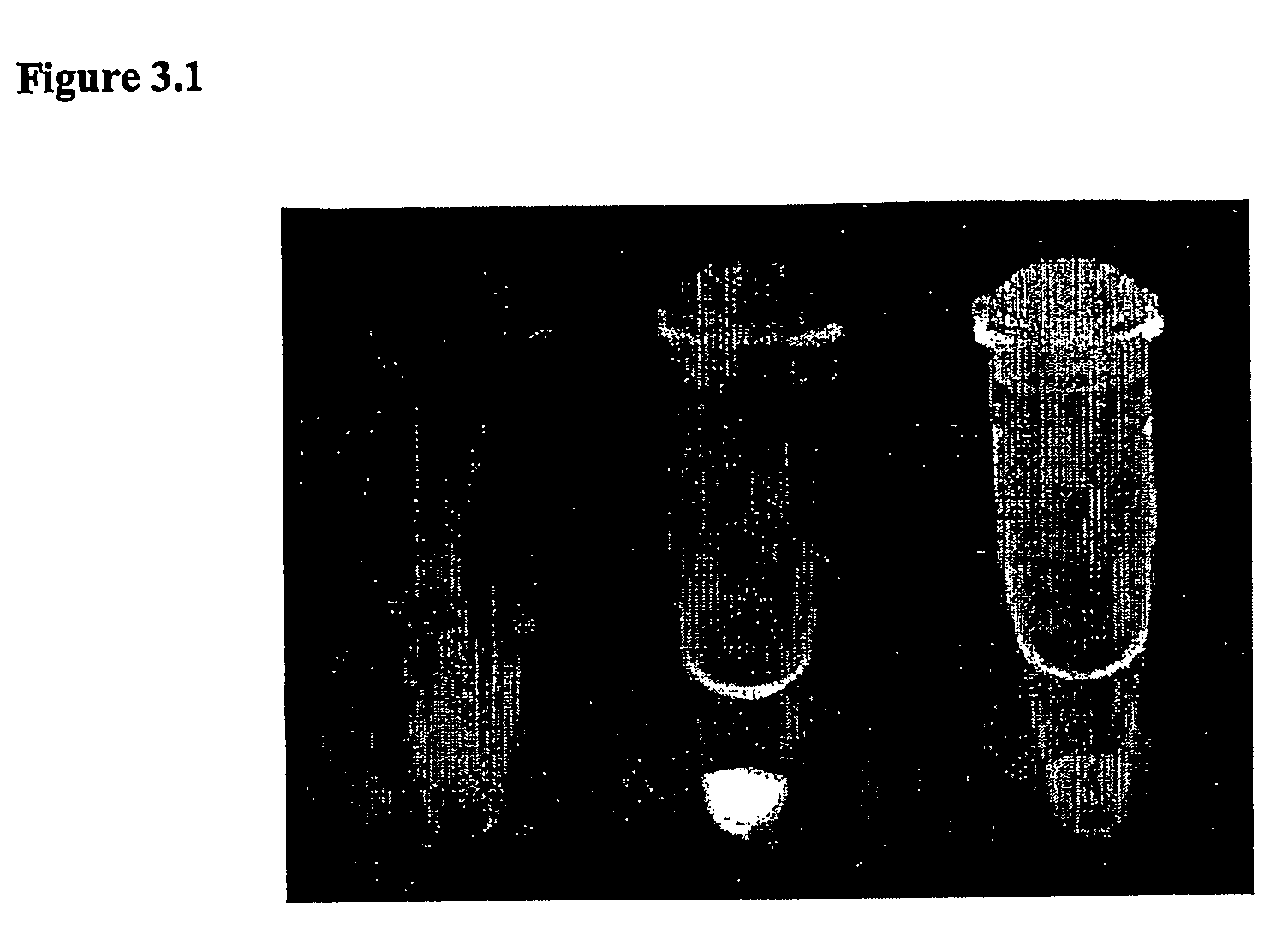Dna amplification and sequencing in collapsible emulsions
a technology of collapsible emulsions and dna amplification, which is applied in the direction of fermentation, microbiological testing/measurement, biochemistry apparatus and processes, etc., can solve the problems of high cost of many reagents, sensitivity of modern analytical equipment, and the cost of dna sequencing reagents, which is responsible for more than 30% of the total cost of obtaining sequence data from a specific dna templa
- Summary
- Abstract
- Description
- Claims
- Application Information
AI Technical Summary
Benefits of technology
Problems solved by technology
Method used
Image
Examples
example 1
PCR Reactions in the Presence of TRITON X-100
[0123] This example demonstrates that the addition of TRITON X-100 has no significant effect on an enzyme reaction when added at levels required to create stable emulsions at 25° C. To establish that enzyme reactions can be performed efficiently in the presence of TRITON X-100, a simple titration experiment of increasing TRITON X-100 concentration in a PCR was performed. The PCR described below demonstrates that high concentrations of TRITON X-100 do not inhibit Taq DNA polymerase-based extension and amplification reactions.
[0124] Each PCR contained the following components: 2 nanograms of the pCR-Blunt II-TOPO vector (Invitrogen, Carlsbad, Calif., USA) containing a 726 bp insert as template (FIG. 1), 5 pmol each of the M13 (−20A) forward sequencing primer (5′-ACTGGCCGTCGTTTTAC-3′; SEQ ID No. 6) and M13 (−21) reverse sequencing primers (5′-AACAGCTATGACCATG-3′; SEQ ID No. 7), 2 microlitres of 25 mM MgCl sub. 2, 2 microlitres of 2 mM dNTP...
example 2
Temperature-Induced Collapse of Emulsions
[0126] Typically, it will be required that the emulsion formed remains relatively stable during reaction set-up and that it collapses just prior to, or during, the reaction process. One means of accomplishing this requirement is by creating the emulsion at a temperature at which it is stable and then performing an incubation step at a higher temperature at which the emulsion is unstable and collapses. The temperature at which the thermal-induced collapse of an emulsion occurs is a function of the inherent cloud point of the surfactant, the concentration of the surfactant, and the presence of additives that affect the solubility of the surfactant either in the aqueous or organic phases (Gu & Galera-Gomez, 1999).
Therma-Induced Collapse of Triton-X100 or Triton-X114 Emulsions with Mineral Oil
[0127] An experiment was performed to establish the temperature profile of different emulsions using incubations at stepwise temperature increments. Emu...
example 3
Change of Reaction Conditions Through Collapse of an Emulsion
[0136] This example demonstrates that an emulsion phase separation (collapse) can be used to change the reaction conditions within the aqueous phase. The emulsion was created from an aqueous solution of the DNA staining compound ethidium bromide in the non polar solvent hexadecane using the detergent TRITON X-114. Ethidium bromide interacts with DNA by intercalation resulting in strong fluorescence under UV-light in the presence of DNA. The emulsion was added to a tube containing dried DNA on its inner surface. Only upon collapse of the emulsion will the DNA and ethidium bromide be able to interact and fluoresces.
[0137] The emulsion was prepared in a 2 ml microcentrifuge tube (Product number: 508-GRN; Quantum Scientific, Paddington, Australia) by vortexing using the VM1 vortex mixer (Ratek Instruments Pty Ltd., Boronia, Australia) at maximum setting. Forty microlitres of water was mixed with 10 microlitres of 10% (v / v) T...
PUM
| Property | Measurement | Unit |
|---|---|---|
| Electric charge | aaaaa | aaaaa |
| Surface resistance | aaaaa | aaaaa |
| Absorbance | aaaaa | aaaaa |
Abstract
Description
Claims
Application Information
 Login to View More
Login to View More - R&D
- Intellectual Property
- Life Sciences
- Materials
- Tech Scout
- Unparalleled Data Quality
- Higher Quality Content
- 60% Fewer Hallucinations
Browse by: Latest US Patents, China's latest patents, Technical Efficacy Thesaurus, Application Domain, Technology Topic, Popular Technical Reports.
© 2025 PatSnap. All rights reserved.Legal|Privacy policy|Modern Slavery Act Transparency Statement|Sitemap|About US| Contact US: help@patsnap.com



